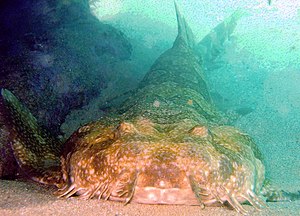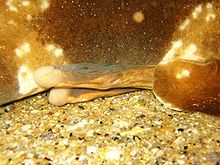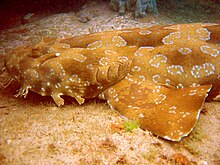Common carpet shark
| Common carpet shark | ||||||||||||
|---|---|---|---|---|---|---|---|---|---|---|---|---|

Common carpet shark ( Orectolobus maculatus ) |
||||||||||||
| Systematics | ||||||||||||
|
||||||||||||
| Scientific name | ||||||||||||
| Orectolobus maculatus | ||||||||||||
| ( Bonnaterre , 1788) |
The common or spotted carpet shark ( Orectolobus maculatus ), also known by the Australian name wobbegong , is a species of the carpet shark family (Orectolobidae). It lives on the south coast of Australia and can reach a body length of over three meters.
The species is generally considered harmless despite its size; Bite accidents mainly occur when bathers or divers step on the animals lying quietly on the seabed. Regionally there is a high fishing pressure on the sharks, so that they are considered endangered especially off New South Wales .
features
The common carpet shark is a large, ground-living shark with an average length of 1.50 to 1.80 m, the largest individual measured so far had a total length of 3.60 m. Like all carpet sharks, it has a very broad, flattened body with a broad head and a large, terminal mouth.
The basic color is beige-greenish or yellowish-brown and it is drawn over the entire body with large, dark saddle spots and roundish spots with a light border. This rich body pattern represents a camouflage color, which in its natural habitat leads to the fact that the animal visually blurs with the rock and coral floor. The two dorsal fins are very far back, so that the beginning of the first dorsal fin lies above the pelvic fins. The pectoral and pelvic fins are very large and broad.
At the lower edge of the upper lip, under the nose and eyes, the shark has six to ten branched skin flaps and long barbels on both sides . The mouth opening is far in front of the head in front of the eyes. The shark has two rows of pointed fangs in the upper jaw and three rows in the lower jaw. The animals have a very large injection hole behind their eyes on both sides and 5 gill slits in front of the pectoral fins.
distribution and habitat
The distribution area of the common carpet shark is off the western and southern coast of Australia from the region north of Fremantle in Western Australia along the entire south coast of the continent to Moreton Island in southern Queensland . Occasionally the South China Sea and the coasts of Japan are also given as a distribution area; however, this is very likely to be confusion with other, closely related species. It can therefore be assumed that the common carpet shark is an endemic species of the Australian coast.
The common carpet shark is a common species in the shallow and near-shore tropical to temperate coastal areas, in the intertidal zone and the flat continental shelf . However, it can also occur at depths of up to 110 m. He prefers coral and rock regions as well as sandy undergrounds. The young animals also often live in estuaries or seagrass meadows . During the day it can be found in caves or under rocky outcrops.
With the exception of the Japanese carpet shark ( O. japonicus ), which can be found on the coasts of Japan and Southeast Asia, all species of the genus live in the coastal waters of Australia. The ornamented carpet shark ( O. ornatus ) also occurs in the entire distribution area of this species, both species are accordingly sympatric . Off the west coast of Australia, the range also overlaps with the western carpet shark ( O. hutchinsi ).
Way of life
The common carpet shark is largely inactive during the day and lies on rocky ground or coral reefs as a stalker or is found individually or in groups in caves, crevices or even in shipwrecks. Its main phases of activity are at night when it is actively searching for food and swimming across the sea floor. Unlike representatives of closely related families such as the bamboo sharks (Hemiscylliidae), however, the carpet sharks do not use their pectoral fins to run across the sea floor, but rather swim with sideways wave movements. They also use this swimming technique in extremely shallow water on the coast, when they go from one tide pool to the next and sometimes come almost completely out of the water.
Diet, predators and parasites
The common carpet shark feeds primarily on bottom-living invertebrates such as crabs , squids and octopuses . However, it also hunts reef-dwelling bonefish such as scorpion fish , sawfish and steerable perch as well as rays and other bottom sharks, including fellow species and other carpet sharks.
Above all, he is a stalker and lies on the sea floor until potential prey animals approach his head and the skin flaps there. These are sucked into the mouth by quickly opening the large mouth and the resulting negative pressure ( suckers ). At night, the sharks also actively hunt by swimming shallow near the ocean floor and catching scared prey.
The relatively small young sharks of the common carpet shark in particular can serve as food for other predatory fish or mammals, including their larger conspecifics. They protect themselves from being stalked by their good camouflage and their hiding places in crevices or under rock overhangs. If the animals are attacked, they become aggressive and snap at the attacker, whereby they can tear severe wounds due to the strong dentition and teeth. At least 33 types of tapeworm and the nematode Echinocephalus overstreeti are known to be endoparasites of the common carpet shark .
Reproduction and development

Little is known about the mating season and reproduction habits of the species. The mating season for captive individuals is in July, during which time rival fights can occur between the males. The males are attracted by sexual attractants ( pheromones ) from the females. They bite into the area of the gills during mating , in which the large clasper of the male are introduced into the cloaca of the female. It is believed that the sharks are polygynous , meaning that the males mate several females during the mating season.
Like all carpet sharks, the common carpet shark is also viviparous ( ovoviviparous ), whereby the eggs develop completely in the uterus and the young sharks hatch in the womb shortly before birth. After an unknown gestation period (up to two years are possible), the females give birth to around 20 young animals, the largest known litter to date comprised 37 young animals. The size of the young sharks is about 20 cm at birth. The young animals leave the mother immediately after birth and hide in deep crevices in the rock or in tide pools in order to avoid the feeding pressure of larger conspecifics, among other things. Like other sharks, carpet sharks grow slowly and for life, reaching sexual maturity at around 60 to 120 cm.
Systematics

The common carpet shark, scientifically described by Pierre Joseph Bonnaterre in 1877, is one of currently eight known species within the genus Orectolobus . This is currently in intensive systematic processing, so that no statements can be made about the relationships within the genus. With the described until 2006 Western Teppichhai ( O. hutchinsi ) and described in 2008 O. floridus and O. parvimaculatus described three new species in recent years, during the 1840 and described as a synonym for ornate wobbegong looked O. halei 2006. was defined as a separate species.
Humans and carpet sharks
Although there have been a number of documented accidents involving these very large sharks, they are generally classified as harmless. Accidents with carpet sharks mainly occur because of the animals' good camouflage, which makes them lie unnoticed on the seabed. People who step on one of these sharks by chance will be bitten in the affect while the shark itself tries to escape. Trapped carpet sharks also bite aggressively to free themselves. Due to the multiple rows of sharp teeth, these bites are painful and, in large sharks, also cause very deep wounds. In some documented cases, carpet shark victims have also lost limbs. Which species of large carpet sharks were responsible for this in the respective cases is usually not traceable.
fishing
The common carpet shark, along with other carpet sharks, is fished commercially in Australia for its highly sought-after meat and the leather made from its skin, and is also a common bycatch in bottom fisheries . In the last few decades the stocks have decreased significantly due to this fishing, for the coasts of New South Wales a decrease of more than 60% (together with the ornamented carpet shark) was found in the years 1990 to 2000. In South and Western Australia, the catch numbers are lower and the populations are correspondingly less endangered.
Carpet sharks are a dreaded pest for the crab and lobster fisheries in Australia because they go into the nets and traps to eat the bait in them and the crabs that have been caught.
tourism
Since carpet sharks are sometimes very large and usually harmless sharks in the reefs, especially for divers, a coveted object, their occurrence in some regions can have a positive effect on tourism . Together with other reef inhabitants, they represent the basis for increasing ecotourism here .
Hazard and protection
In the Red List of Threatened Species of the International Union for Conservation of Nature and Natural Resources (IUCN), the common carpet shark is classified as a species not endangered ("least concern"). The justification is that there is currently no evidence of a population decline of the species and the current catches are relatively low. In earlier surveys in 2003 and 2009, on the other hand, the shark was listed as a species on the “warning list” ( near threatened ). Regionally, especially in New South Wales , the stocks declined sharply due to the high fishing pressure, so that the shark was sometimes classified as "endangered" ( vulnerable ). The species lives locally within its relatively shallow water area and has been caught in commercial and recreational fisheries as a target species and as bycatch. In New South Wales, however, carpet shark catches fell by more than 50% between 1997/1998 and 2007/08 and then stabilized at around 20 tons per year. The fishing effort reported as the number of fishing days also decreased between 1990/91 and 2008/09, which meant that the catch rate from 1990/91 to 2009 was relatively constant at around 15 kg per day of fishing. Since September 2006, carpet sharks are limited in the daily catch limit for a list of shark species to one ton for a period of 24 hours and two tons for 48 hours or more. With new management regulations, a daily limit of six carpet sharks was introduced in May 2008. A minimum size limit of 130 cm total length for the common carpet shark was introduced between 2008 and 2013 and protects the young sharks. Although the minimum size limit is no longer in effect, carpet sharks are no longer being caught to the same extent as before and stocks have recovered; in other Australian states (Western Australia, Queensland, South Australia and Victoria), carpet sharks are not caught and bycatch levels are low.
The main threat to the carpet shark population comes from the very high fishing pressure locally off the coasts of South and West Australia, with the animals being caught mainly as bycatch. The spear fishing , which is mainly done by Aborigines , does not pose a threat to the sharks, as only small numbers of individuals are caught. The leather industry currently hardly uses the hides of carpet sharks. To what extent habitat destruction affects carpet sharks is largely unknown; Above all, the decline in seagrass meadows and the pollution of the estuaries , which represent a retreat for young sharks, could have a negative effect on the development of the population.
The habitat of some carpet sharks is in the existing sanctuaries set up for the sand tiger shark ( Carcharias taurus ), and common carpet sharks in the sanctuaries Julian Rocks Aquatic Reserve , Solitary Islands Marine Park , Fly Point-Halifax Park Aquatic Reserve and Jervis Bay Marine Park in front. Carpet sharks are not listed as endangered in the United States Endangered Species Act or in the appendices to the Washington Convention on Endangered Species (CITES).
supporting documents
- ↑ a b c d e f g h i j k l Tanya Dewey, Todd Szcodronski: Orectolobus maculatus in the Animal Diversity Net. Retrieved November 3, 2008
- ↑ a b c d e f Campagno et al. 2002
- ↑ Peter R. Last, Justin A. Chidlow, Leonard JV Compagno: A new wobbegong shark, Orectolobus hutchinsi n. Sp. (Orectolobiformes: Orectolobidae) from southwestern Australia. Zootaxa 1239, 2006; Pp. 35-48. ( Full text ; PDF; 15 kB)
- ↑ a b Peter R. Last, Justin A. Chidlow: Two new wobbegong sharks, Orectolobus floridus sp. nov. and O. parvimaculatus sp. nov. (Orectolobiformes: Orectolobidae), from southwestern Australia. Zootaxa 1673, 2008; Pp. 49-67. ( Full text )
- ↑ Charlie Huveneers: Redescription of two species of wobbegongs (Chondrichthyes: Orectolobidae) with elevation of Orectolobus halei Whitley 1940 to species level. Zootaxa 1284, 2006; Pp. 29-51. ( Full text ; PDF; 18 kB)
- ↑ a b c d e f g h Orectolobus maculatus in the endangered Red List species the IUCN 2020 Posted by: C. Huveneers, DA Pollard, I. Gordon, AA Flaherty, J. Pogonoski, 2015. Retrieved on June 9th, 2020 .
literature
- LJV Compagno : Sharks of the world. An annotated and illustrated catalog of shark species known to date. Volume 2. Bullhead, mackerel and carpet sharks (Heterodontiformes, Lamniformes and Orectolobiformes). FAO Species Catalog for Fishery Purposes. No. 1, Vol. 2. FAO Rome 2001 ( Complete PDF , Orectolobidae , species portrait ).
- Leonard Compagno, Marc Dando, Sarah Fowler: Sharks of the World. Princeton Field Guides, Princeton University Press , Princeton / Oxford 2005, ISBN 978-0-691-12072-0 , p. 330.
- Ralf M. Hennemann: Sharks and rays worldwide. Jahr-Verlag, Hamburg 2001, ISBN 3-86132-584-5 , p. 16.
Web links
- Common Carpet Shark on Fishbase.org (English)
- Tanya Dewey, Todd Szcodronski: Orectolobus maculatus in the Animal Diversity Net
- Dane Eagle: Spotted Wobbegong at the Florida Museum of Natural History
- Species portrait on hai.ch
- Species portrait in the UN Atlas of the Oceans

